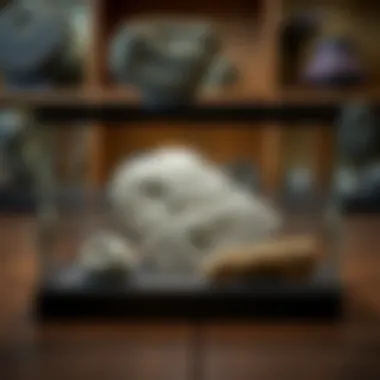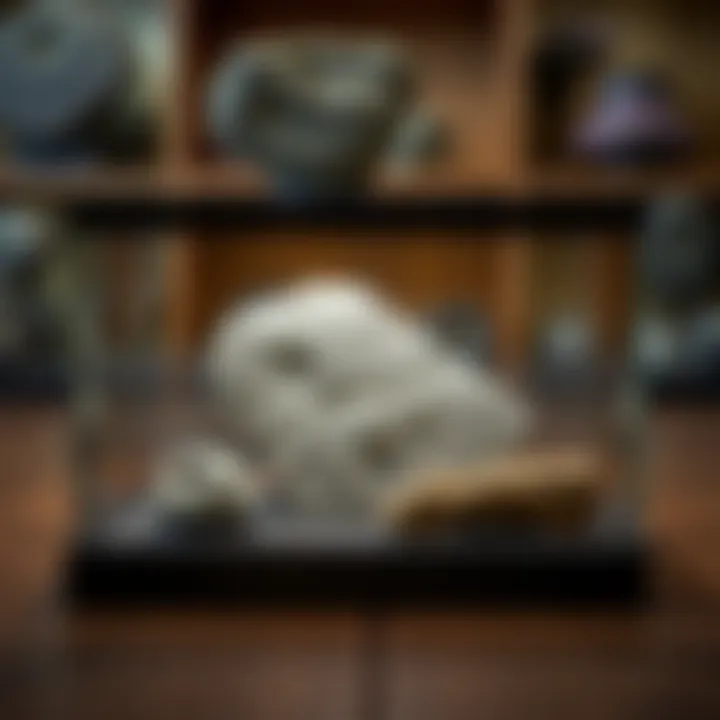The Importance of Fossil Display Boxes in Collecting


Intro
In the world of collecting, fossil display boxes play a more crucial role than one might think. They are not merely containers but integral parts of the collecting experience, serving multiple purposes from preservation to presentation. This article aims to unpack the importance of these display boxes, diving into their historical origins, classification of fossils, and best practices in care and maintenance. Each aspect will shed light on how these boxes can enhance the appreciation and longevity of fossil specimens, particularly for those with a passion for natural history.
History and Origins
Overview of Collectibles, Rocks, and Fossils
Fossils have captured human interest for centuries, acting as tangible links to distant pasts. From ancient civilizations that revered fossilized remains as tokens of divine presence to modern collectors who seek to own a piece of Earth's history, the allure of fossils is timeless. The act of collecting itself has roots that stretch back into antiquity, where items of natural history held not only aesthetic value but also educational significance.
Display boxes, on the other hand, came as a response to the collectors’ need for artifact preservation. Initially crafted from simple materials, the concept of a display box has evolved alongside the growing appreciation for fossils. As scientific understanding deepened, collectors began to understand the nuances of environmental factors affecting the integrity and appearance of fossils. Thus, display boxes transformed into vital tools for safeguarding these treasures against humidity, dust, and light.
Historical Significance and Cultural Impact
Throughout history, fossils have informed our understanding of evolution, extinction, and the ecological changes of our planet. As such, the cultural significance of fossils cannot be overstated. They have inspired art, informed science, and even ignited whole movements in both conservation and collecting.
Fossil display boxes—constructed to enhance both aesthetics and the protective measures surrounding these specimens—are a testament to the evolving relationship between people and their natural history. Whether displayed in a home or a museum, these boxes elevate fossils beyond simple collectibles, rendering them as artifacts worthy of admiration and study.
Identification and Classification
Guide to Identifying Rocks and Fossils
Identifying fossils can be a journey of discovery. Factors such as texture, coloration, and structure often hold the key to classification. Fossils might appear as shell imprints, bone fragments, or even entire organisms encased in sedimentary rock. Collectors must familiarize themselves with these characteristics to not only appreciate their finds but also to ensure they are housed appropriately within display boxes.
Common Types and Variations
Fossils can be broadly categorized into several types:
- Body Fossils: Remnants of the actual organism, such as bones and teeth.
- Trace Fossils: Indications of activity, such as footprints or burrows.
- Chemical Fossils: Residues of biological origins preserved in rock.
Understanding these types assists collectors in choosing the right display boxes suited to their specific needs.
A well-constructed fossil display box not only showcases the beauty of the specimen but also serves as a protective environment, preserving them for future generations.
In summary, fossil display boxes are more than they appear at first glance. As essential tools in the practice of collecting, they enhance the beauty and longevity, affirming the deep-rooted connection between our past and present. In navigating through the subsequent sections, we will delve into materials, innovative care practices, and more, providing a holistic view tailored for collectors, both seasoned and novice.
Understanding Fossil Display Boxes
Fossil display boxes are not merely decorative items; they serve a critical function in the realm of paleontological collecting. These specialized containers are designed to showcase the beauty and complexity of fossils while simultaneously offering protective benefits. Collectors, both amateur and professional, recognize that the preservation of these ancient remnants of life hinges on appropriate display methods. As such, it's essential to gain a firm grasp on the nuances of fossil display boxes—their design, materials, and overall importance in fostering appreciation for these breathtaking specimens.
Definition and Purpose
At its core, a fossil display box is a container designed to protect and exhibit fossil specimens. These boxes are crafted to shield fossils from various environmental hazards, including dust, humidity, and harmful light sources. The primary purpose of these boxes is threefold: to preserve the integrity of the fossils, to enhance their visual appeal, and to facilitate a means of safe handling. By utilizing display boxes, collectors can effectively minimize the risk of damage while elevating the overall presentation of their cherished findings.
Notably, various design features come into play when considering the purpose of display boxes. For instance, many boxes are lined with materials that cushion delicate fossils from shocks or vibrations. Furthermore, clear acrylic or glass fronts allow enthusiasts to appreciate the details within without needing to remove the specimens. The interplay of these functional aspects with an aesthetic sense promotes a lasting connection between the viewer and the ancient world represented by each fossil.
Historical Context
The history of fossil display boxes is a story interwoven with the evolution of collecting itself. In the early days of natural history, fossils were often displayed in makeshift arrangements, with little thought given to the preservation of the specimens or the aesthetic presentation. Many prized finds would end up damaged or dulled due to exposure to the elements or improper handling.
As the field of paleontology matured, so too did the understanding of the need for effective display solutions. During the 19th century, collectors began to adopt glass cases and other protective formats to safeguard their specimens. This marked a significant shift in how fossils were viewed and valued—not just as objects of scientific inquiry but also as pieces of art and history that deserved to be showcased with care.
Over the decades, the rise of various materials such as wood, acrylic, and glass has facilitated an array of stylish and secure display options. Collectors worldwide have offset historical challenges with thoughtfully designed fossil display boxes, turning them into a significant aspect of the collecting culture. In essence, understanding the historical context of fossil display boxes provides insight into how the practice of collecting has transformed into an art form, reflecting both scientific appreciation and aesthetic sensibility.
Key Features of Fossil Display Boxes
Fossil display boxes are more than mere containers; they serve distinct purposes that enhance both the protection and presentation of precious specimens. Selection of the right features in these display boxes is pivotal as it impacts longevity, aesthetic appeal, and the overall experience of both collectors and observers. This section elucidates essential elements such as materials and design that bring out the best in fossil displays.
Materials Used
Wood
Wood has long been a favorite option for many collectors. It brings a sense of warmth and authenticity to fossil displays. Generally considered a durable material, wood, like oak or walnut, offers a sturdy base that ensures protection against various risks. A significant characteristic of wood is its ability to absorb moisture, which can be beneficial in creating a stable environment for fossils.


However, wood displays require treatment to prevent rot or insect infestations. Therefore, while using wood can enhance aesthetic charm, it demands careful attention to maintenance. A disadvantage might be the potential for warping over time, especially in fluctuating humidity levels. In contrast to other materials, wood really shines when combined with proper preservation techniques.
Acrylic
Acrylic is a modern contender in the world of fossil display materials. Its lightweight nature makes it practical for transporting and arranging fossils without the fear of breakage. One of the standout features of acrylic is its clarity, allowing for full visibility of fossil details without obstruction. This benefits collectors who wish to showcase intricate designs and textures.
On the flip side, acrylic can scratch relatively easily, making regular cleaning essential to maintain its visual allure. Even so, the balance between durability and visibility makes acrylic a popular choice today. It is perfect for less robust specimens that may need a bit of gentle handling.
Glass
Glass is perhaps the most classic material for display boxes, unmatched in providing clarity and elegance. A significant aspect of glass is its ability to block harmful UV rays, offering excellent protection against fading. It creates a museum-quality presentation that can be very appealing to collectors seeking a sophisticated display setting.
However, glass can be heavy and prone to shattering, a risk that any collector must weigh carefully. Though the refined appearance is difficult to beat, one must ensure secure placement to avoid accidents. Those who opt for glass should consider designs that incorporate safety features to mitigate these downsides.
Design Elements
Size and Shape
The size and shape of a fossil display box play crucial roles in how well the specimens are presented. A box that complements the fossil's proportions ensures that the specimen is not cramped, promoting a more appealing look. An adequate size can also accommodate additional items, such as labels or information cards, which enhances educational value.
Different shapes—be it rectangular, circular, or custom designs—can support various presentation styles. Choices here can reflect an individual collector's expression, thus adding to the display's charm. Yet, the downside can be the limitation in accommodating particularly large fossils, which might necessitate oversized custom boxes. It’s a careful dance between form and function.
Color Schemes and Aesthetic Appeal
The color schemes of display boxes can significantly impact viewers' perceptions and emotions toward the showcased fossils. Lighter colors can create an illusion of space and makes fossils pop, while darker hues provide a dramatic backdrop that can enhance the overall aesthetic. This choice directly influences the viewer's engagement and interaction.
However, using bright colors, though attention-grabbing, risks overwhelming the subtle details of the fossils. Each collector must consider not only the visual appeal but also how it intersects with the fossil's inherent properties. Striking a harmonious balance ensures that both specimen and display work in concert, amplifying the beauty of the fossil.
"The right display not only protects a fossil but also tells its story."
Choosing the right features for fossil display boxes is crucial for ensuring the longevity and appreciation of collected specimens. An insightful approach to materials and design helps highlight each fossil's unique characteristics while providing essential protection against environmental factors.
Preservation and Protection Considerations
The preservation and protection of fossil specimens are paramount in the world of collecting. Proper display boxes serve not just as housing for fossils but as essential guardians against the elements and physical threats. They can significantly enhance longevity and aesthetic charm, making thoughtful selection of these display solutions crucial.
Environmental Factors
Humidity Control
Humidity control is one crucial element in protecting fossils from deterioration. Fossils, often porous, can absorb moisture from the surrounding environment, leading to decay or mineral alteration. Display boxes constructed with materials designed to regulate humidity can create a stable internal atmosphere. This allows collectors to avoid the perils of humidity fluctuations that may warp or damage fossils over time. A unique feature of these specialized boxes is that they often include hygrometers or moisture-absorbing elements, offering a clear indication to the owner about the internal conditions. Regular monitoring, while arguably a bit of a hassle, can prevent countless headaches for the collector down the line.
UV Light Exposure
UV light can be invisible enemy number one for fossils. Prolonged exposure often leads to color fading, and surface degradation, which can drastically diminish their visual appeal. Display boxes that incorporate UV-filtering glass or acrylic can be a game changer. These materials are especially beneficial because they block harmful rays while still allowing for vibrant illumination. Even the most beautiful specimens may lose their charm in direct sunlight, making UV protection a top priority for anyone keen on showcasing their collection. Nonetheless, it’s worth noting that not all display cases offer the same level of protection, and some may require additional shielding depending on their placement.
Physical Damage Prevention
Shock Absorption
When it comes to fossils, prevention of physical damage cannot be overlooked. Shock absorption features in display boxes play a significant role in ensuring fossils are safe from impacts. Whether it’s an accidental bump or a small tremor in the environment, many quality display boxes come with padded interiors or shock-resistant materials, effectively acting like a cushy pillow for your prized possessions. A benefit of these shock-absorbent materials is that they can mitigate the risk of breaking or chipping during transport or even in casual moments of display. However, the downside is that some designs may appear bulkier, impacting aesthetic appeal for some collectors.
Secure Fastening Methods
A reliable fastening method is key to ensure that fossils remain undisturbed and protected. Display boxes with robust latching systems or magnetic closures provide peace of mind, safeguarding your collection against accidental openings. It is paramount that the fastening methods do not hinder quick access, as collectors often enjoy showcasing their fossils. One unique feature found in some display boxes is their combination of traditional locks and modern magnetism, balancing security with convenience. But one must be cautious: overly complex fastening may deter owners from accessing their treasures regularly, which can, in turn, diminish engagement with their collection.
"The right display box is not just a case; it's a fortress for your fossil treasures."
In summary, the considerations in preservation and protection are numerous. Maintaining an ideal environment along with minimizing physical threats are pillars of fossil collection. As collectors, being mindful of these aspects can not only protect but also elevate the appreciation of our natural history treasures.
The Role of Display in Showcasing Fossils
When it comes to showcasing fossils, display plays a pivotal role. Beyond mere visibility, how fossils are presented can profoundly affect their impact, educational value, and the appreciation by viewers. A thoughtful display can transform a simple fossil into a conversation starter, inviting curiosity from novices and seasoned collectors alike. The importance extends into aesthetics and didactic opportunities, making the role of display in fossil showcasing multifaceted and significant.
Aesthetic Appeal


A fossil may be thousands—or even millions—of years old, yet how it’s presented can breathe new life into its story. A well-designed fossil display box not only protects the specimen but enhances its visual appeal. For instance, a striking wood display box with a glass top showcases the fossil clearly while adding a touch of elegance.
Attributes such as size and shape are important considerations. Unique fossils, like a delicate ammonite, may be displayed prominently in a custom box shaped to accentuate its spiral form. Color also adds an instrumental layer. Background hues can either complement or contrast the tones of the fossil, creating a striking visual impact. Furthermore, transparent or semi-transparent materials can maximize light exposure without harming the fossil, lending an ethereal quality to the display. This harmony between design and specimen becomes an essential factor in the overall engagement and admiration from viewers.
Educational Value
Display boxes serve a crucial role in education, especially for collectors who seek to pass down knowledge to the next generation. Fossils are windows to the past, and how they are exhibited can directly influence understanding. Educational plaques or engravings in a display case can offer insights about the fossil's origin, its geological timeframe, or the environment it once inhabited.
A thoughtful display encourages inquisitiveness, igniting discussions among family members, friends, or even groups at community exhibits. It can provide context that a simple photo in a book can never achieve. Such educational features open doors to deeper conversations about paleontology, geology, and environmental science.
In addition, interactive features can be increasingly employed in modern displays. Perhaps a display box could include a QR code linking to a detailed webpage or even virtual reality experiences, enhancing the engagement factor. Clearly, the role of displays extends beyond aesthetics; it’s about fostering appreciation and understanding of these remarkable specimens.
"The way you display a fossil can speak volumes about its significance and history."
Custom Display Solutions for Unique Specimens
When it comes to showcasing fossils, not all specimens are created equal. Some may be exceptionally rare or have unique characteristics that call for individualized display strategies. Custom display solutions play a pivotal role in ensuring that each fossil is not just preserved but celebrated for its distinctiveness. By tailoring designs to fit the specifics of a specimen, collectors can enhance visibility and protection while also adding a personal touch that resonates with their passion for paleontology.
Tailored Designs
Personalized Boxes
Personalized boxes offer a chance for collectors to leave their mark, literally and figuratively. By crafting display boxes that are unique to each specimen's size and style, collectors can effectively enhance the viewing experience.
The key characteristic of personalized boxes is the ability to incorporate custom fitment options. This feature ensures that every fossil snugly fits within its box, minimizing movement that can lead to damage. Hence, personalized boxes are favored for their adaptability to various fossil shapes and dimensions.
However, not all materials have the same durability. For instance, a beautifully crafted wooden box may provide aesthetic value, but it might not afford the same level of protection against environmental factors compared to acrylic. Still, personal touch often prevails in the hearts of collectors, making these boxes a popular choice for their sentimental value.
Engraving and Signage
Engraving and signage contribute significantly to the presentation of fossils. These elements not only provide essential information about the specimen but also enhance the overall aesthetic of the display. An engraved box can feature the name, origin, and age of the fossil, making it informative and visually appealing.
The shining advantage of engravings is their permanence. Unlike labels that may peel off or fade over time, engravings remain clear and legible for years. This durability makes it a favored option among collectors who want their displays to stand the test of time. However, the downside is that customized engraving can come at a higher cost than basic signage options.
Innovative Displays
Modular Systems
Modular display systems are transforming how fossils are exhibited, allowing collectors to mix and match components as needed. Their flexibility is unparalleled; a collector can easily rearrange display elements to accommodate new acquisitions or adapt to changing display spaces.
The standout characteristic of modular systems is their expandability. When a new fossil is added to a collection, a modular system can usually be adjusted without requiring a complete overhaul of the existing setup. However, these systems may lack the solidity of more traditional display cases, which can concern collectors of particularly fragile specimens.
Interactive Features
Interactive features in fossil displays are increasingly gaining traction. Things like augmented reality elements or physical touchpoints enable viewers to engage more deeply with the specimen. This accessibility promotes a better understanding of the fossil’s historical context and scientific significance, enriching the educational aspect of the display.
A noteworthy benefit of such interactive features is their capacity to engage a wider audience, turning a passive viewing experience into an active learning opportunity. They can, however, be more costly and technologically demanding, which could be a barrier for some collectors.
Community and Collector Insight
The world of fossil collecting is more than just acquisitions of remarkable specimens; it is a thriving community that shares experiences, knowledge, and passion. The significance of community and collector insight cannot be overstated, as it connects individuals who are not just hobbyists but are also guardians of history.
Sharing narratives from the field of collection enriches this experience. Collectors often have unique stories tied to their fossils, which can span decades. For example, a collector might recount the thrill of excavating a rare trilobite, detailing the weather conditions, the tools used, and the palpable excitement of discovery. These anecdotes do more than just entertain. They build a sense of trust, camaraderie, and belonging in the community. Each story becomes a thread woven into the fabric of collective history, encouraging newer collectors to engage and share their findings.
Stories from Collectors
Consider the story of Mike, a dedicated fossil enthusiast who began his journey in Oklahoma. His first significant find was a well-preserved dinosaur bone, which he stumbled upon during a casual hike. Mike shared this story during a local fossil fair, where he explained how the thrill of that find paved the way for his current vast collection. By openly sharing the challenges and triumphs of his collecting journey, Mike inspired newcomers to pursue their interests wholeheartedly, regardless of how daunting it felt.
Such stories are invaluable. They foster mentorship and educational exchange, paving avenues for collaboration among seasoned and rookie collectors alike. An informal exchange may lead to more formal workshops or lecture series within the community, ultimately enhancing skills in preservation and display techniques.
Display Practices in Community Exhibits
Exhibiting fossils requires not just proper display boxes but also consideration for context and interpretation. Community exhibits serve as a platform where collectors present their carefully curated pieces. Here’s where insight into best display practices becomes critically relevant.


- Contextual Storytelling: The best displays tell a story. An exhibit showing a paleoecosystem includes not only fossils but also information about the habitat in which they were found.
- Interactive Features: Some exhibits incorporate touch screens or QR codes, allowing visitors to delve deeper into the story behind each fossil, as well as to learn about the collector's journey. This adds a layer of engagement that traditional displays might lack.
- Sustainable Practices: Community exhibits also reflect a growing trend towards sustainability. Collectors increasingly incorporate sustainable materials and practices in their displays, showcasing their commitment to environmental stewardship.
The influence of shared practices in this realm is crucial. Apart from enhancing knowledge and skills, they contribute to elevating the standards of fossil display. Ultimately, engagement and collaborative insights among collectors lead to a richer understanding of paleontology.
As fossil collectors exchange experiences and practices, they create not only displays but also bonds of friendship and networks that foster mutual understanding and growth. For more insights and conversations about fossil display strategies, you can visit resources such as reddit.com, or delve into the world of exhibitions at britannica.com.
It’s this sense of community that transforms fossil collecting from a solitary pastime into a vibrant and collaborative journey through time.
Best Practices for Care and Maintenance
Caring for fossil specimens isn’t just a matter of aesthetics; it’s about preservation and ensuring that these ancient treasures stand the test of time. Proper care and maintenance of fossil display boxes play a vital role in safeguarding the fossils within them. Employing best practices not only protects specimens from physical damage but also maintains their scientific and monetary value.
Cleaning and Handling
The first step towards effective maintenance is understanding how to properly clean and handle fossils. Dusting may seem like a simple chore, but improper techniques can cause more harm than good. Here are some critical tips to keep in mind:
- Use Soft Brushes: For the gentle removal of dust, always opt for a soft brush. Natural bristle brushes are ideal since synthetic bristles might scratch delicate surfaces.
- Avoid Water and Chemicals: Fossils are sensitive to moisture and chemicals, which can lead to deterioration. Stick to dry methods unless you are dealing with very specific types of fossils that permit moisture, like certain types of amber.
- Wear Gloves: Oils from our fingers can leave marks or damage fossil surfaces. Wearing nitrile or latex gloves when handling fossils can help mitigate this risk.
- Support the Fossil's Structure: If the fossil is of significant weight or size, always support it from underneath. This practice avoids stress that could lead to fractures.
"The preservation of fossils is not merely a matter of caretaking; it is a realm of responsibility toward our shared natural history."
By following these guidelines, collectors ensure that their fossils remain in pristine condition, ready to share their stories with future generations.
Storage Solutions
Besides cleaning, effective storage is paramount in prolonging the life of fossil specimens. How one stores their precious finds can mean the difference between a well-preserved fossil and one succumbing to environmental perils. Here are some insightful storage solutions for fossil display boxes:
- Environmentally Controlled Spaces: Storing fossils in areas with controlled temperature and humidity is key. Aim for a cool, dry place that avoids extremes and rapid fluctuations in conditions.
- Use Acid-Free Materials: When using packing materials, choose acid-free options to prevent chemical reactions that might harm the fossils over time.
- Individual Compartments: For valuable or fragile specimens, consider display boxes with individual compartments. This feature minimizes movement and significantly reduces the risk of damage.
- Keep Away from Sunlight: Prolonged exposure to direct sunlight can fade and weaken fossils. Store display boxes in shaded areas or use UV-filtering glass in displays to prevent this issue.
In summary, durable storage solutions can not only protect fossils from direct damage but also contribute to their overall integrity over time. With these best practices, collectors can feel confident in their approach to caring for the remarkable pieces of history that they hold dear.
Future Trends in Fossil Display
As the world of fossil collecting accelerates into the digital age, it's vital to look at emerging trends in fossil display. This section addresses Future Trends in Fossil Display, focusing on how technological advancements and sustainable practices will reshape the way collectors showcase their prized specimens. Understanding these trends is essential for collectors who want to enhance both the appeal and longevity of their fossils.
Technological Innovations
The rapid advancements in technology are significantly influencing the way fossils are displayed. One standout innovation is the use of augmented reality (AR), allowing collectors to create interactive layers of information over their fossils. Imagine pointing your mobile device at a display box and accessing a 3D model of the fossil or its environment, displaying details about its age, geographic origin, and the ecological context in which it existed. This interaction not only enriches the viewer’s experience but also enhances educational opportunities for younger audiences excited about paleontology.
Another technological shift gaining traction is the integration of smart materials into fossil display boxes. These materials can change properties based on environmental conditions, automatically adjusting to humidity and temperature fluctuations. This means that fossils get dynamic protection, constantly working to maintain optimal conditions. Furthermore, there are innovative LED lighting solutions, which allow for customizable light displays that can enhance the visibility of the fossil's features while ensuring that UV rays are minimized, thus protecting the integrity of the specimen over time.
Lastly, we cannot overlook the impact of online platforms. Digital galleries are springing up, giving collectors a chance to display their fossils without physical limitations. Forum-based communities also encourage collectors to share tips and tricks about display techniques, leading to an enhanced collective knowledge. This digital realm is vibrant, allowing different perspectives on fossil display that can inspire unique approaches at home.
Sustainable Practices
With an increasing awareness about environmental concerns, sustainable practices in fossil display is more sought after than ever. Many collectors are now opting for eco-friendly materials for their display boxes. Instead of conventional plastics or wood from unsustainable sources, collectors are turning to recycled materials or responsibly-sourced woods. For instance, some display boxes are being made from bamboo, known for its rapid growth and sustainable harvesting.
Another trend is the reduction of carbon footprint by creating local partnerships for production, rather than outsourcing materials overseas. This localized economy not only helps preserve craftsmanship but also fosters a community spirit among collectors.
Moreover, collectors are increasingly aware of the impact of fossil capturing on ecosystems. There's a growing movement advocating for ethical collecting practices, ensuring that fossils are obtained responsibly and displayed in ways that respect their origins. Displaying fossils in biophilic designs, which integrate living elements (like plants) into the display, can further promote awareness regarding natural ecosystems and the importance of preserving them.
As we look to the future of fossil display, these technological innovations paired with a commitment to sustainability not only enhance the experience for the collector but also ensure that we are doing our part in protecting our planet and its history.
Ending
Fossil display boxes serve as much more than mere storage; they embody a confluence of preservation, education, and appreciation for the intricate world of paleontology. This article has walked through the various aspects regarding these integral components of fossil collecting, underscoring their necessity in the collector's journey.
Summary of Key Points
To distill the essence of the information shared:
- Preservation is Paramount: Display boxes are crafted not only to showcase but to safeguard fossils from environmental factors such as humidity and UV light, ensuring longevity.
- Design Matters: The aesthetic appeal and functionality are inseparable. Whether it's acrylic or wooden cases, the right design captures attention and enhances the viewing experience.
- Customization Options: There is an increasing trend toward personalized solutions. Tailored designs can be created to fit the unique characteristics of each fossil, enhancing its narrative in a collector's display.
- Community Engagement: The shared stories and practices in the collector community elevate the appreciation of fossils. Many enthusiasts find inspiration and validation from each other, often exchanging tips on display solutions and care techniques.
- Looking Ahead: With technological advancements and a growing focus on sustainability, the future of fossil display is evolving, promising innovative storage and showcasing methods.
"A well-displayed fossil is not just an item; it's a story that echoes through time."
Encouragement for Collectors
As we wrap up this exploration of fossil display boxes, it is crucial to recognize the empowering role they play in the world of collecting. Collectors are encouraged to view their display boxes as an extension of their passion rather than simply as inert containers. Dive into personalization options with your display solutions. Don't hesitate to engrave a personal touch or craft a narrative around each specimen.
Being a part of the collector community fosters a deeper appreciation for the art of fossil collection. Attend exhibits, share your own experiences, and absorb the wealth of knowledge that other collectors dispense. The journey of collecting fossils is enriched significantly when displayed thoughtfully.
Ultimately, bringing these ancient treasures to life through the right displays elevates not only the specimens themselves but also the stories they tell and the community they represent. Make each fossil box a testament to your dedication and love for natural history!



